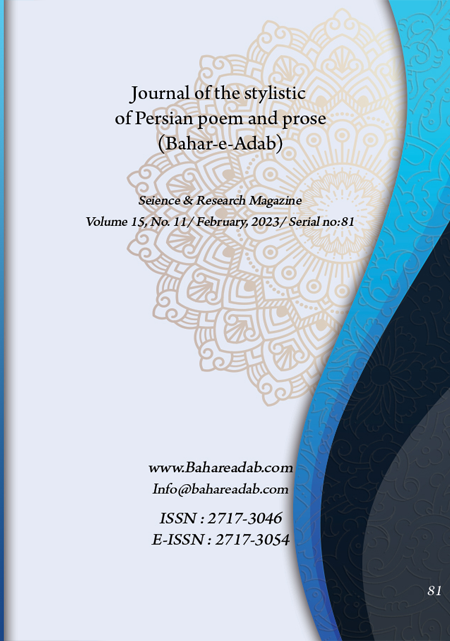- Count View : 346
- آدرس کوتاه شده مقاله: https://bahareadab.com/article_id/1394
- کد doi مقاله: Doi: 10.22034/bahareadab.2023 .15 .6708
Journal of the stylistic of Persian poem and prose
volume Number 15،
number In Volume 11،
،
issue Number 81
Stylistics of Abbas Bagheri's poems (Collections Sobh dar pargar and Az pelk-e- sang)
Yousef Karami Chemeh (Author in Charge)
Abstract
BACKGROUND AND OBJECTIVES: The poetry of the Islamic Revolution and the Holy Defense is one of the branches of the great tree of contemporary Persian poetry. This type of poetry, which is often known for its features and content characteristics, also has its own linguistic and expressive characteristics. Abbas Bagheri, the famous poet of Sistani, is one of the poets with the style of poetry of the Islamic Revolution and the Holy Defense. This article, two collections of his poems are stylized.
METHODOLOGY: In the present article, the method of text analysis and library resources is used and the study area and community are two collections of Morning in the compass (1989) And from the eyelid of the stone (2007).
FINDINGS: Frequency of religious and mystical words; War words and expressions and geographical names related to the front; There are more Arabic words and expressions in the collection " From the eyelid of the stone". The frequency of native and local names and words in his poetry is remarkable. The most important forms of his poetry are similes (especially sensory to sensory and metaphorical addition) and allusions (especially religious allusions). Attention to martyrdom and martyrdom, Ashura and Karbala, veterans and freedmen, families of warriors, patriotism, struggle against colonialism and ignorance and materialism of neighboring rulers and the expression of poverty and economic problems are among the themes of his poetry.
CONCLUSION: It can be said that there is a connection between these two books and in general all Bagheri"s poems in terms of form, form and content. Bagheri"s poems are mostly in free and Nimai"s formats and have been written in simple and fluent language and using simple and familiar images. In the poems of these two books, mainly social themes such as attention to poverty and economic problems, ignorance and oppression of neighboring rulers, colonialism and capitalism, historical confrontation between right and wrong and themes related to holy defense and revolution are seen. In his poetry, the influence of culture, history, climate and nature of Sistan is prominent.
Keyword
Abbas Bagheri
, Morning in Pergar
, From the Eyelid of the Stone
, Stylistics
- Alipour, Mustafa. (2001). The Structure of Today's Poetry Language, Tehran: Ferdows.
- Bagheri, Abbas. (1989). Morning in compass, Tehran: Barg.
- Bagheri, Abbas. (2007). From the eyelid of the stone, Tehran: Sarir.
- Ghasem Nejad, Ali. (1997). "War Literature", Persian Literature Dictionary, Under the Exposition of Hasan Anousheh, Tehran: Publishing and Printing Organization of the Ministry of Culture and Islamic Guidance, pp. 48-52.
- Gorjizad, Reza. (2009). The pain of the songs of the difficult times, Keyhan Farhangi, No. 276 and 277, pp. 78-80.
- Haddad Khanshan, Maryam. Amani, Rostam & Farzi, Hamidreza. (2021). Stylistic analysis of the introductory poems to the Persons of the Resistance of the Islamic Revolution and the Sacred defense (Based on a review of the poetry of Fifteen poets). Journal of Stylistics of Persian Poetry and Prose, (14) 62, pp. 141-161.
- Hoghughi, Mohammad. (1998). New Poetry from the Beginning to Today, Volume I, Tehran: Sales.
- Homaiei, Jalal al-Din. (1992). Rhetoric and literary crafts, Tehran: Homa.
- Kafi, Gholam Reza. (2002). Manual on Fire, Shiraz: Navid-e- Shiraz.
- Kakai, Abdul Jabbar. (1997). Songs of the Red Generation, Tehran: Orouj Publishing Institute.
- Kakai, Abdul Jabbar. (2001). A Comparative Study of Sustainability Issues in Iranian and World Poetry, Tehran: Palizan.
- Kazemi, Mohammad Kazem. (2011). Ten Poets of the Revolution, Tehran: Soore Mehr.
- Keramat, Seyed Alinaghi. (2016). The sound of the river, Tehran: Maroon.
- Khajehnesir al-Din Toosi (1976). Asas –o- el eghtebs, Mohammad Taghi Modarres Razavi (emend.), Tehran: University of Tehran.
- Meqdadi, Bahram. (1999). Dictionary of Literary Criticism (from Plato to the Present), Tehran: Fekr-e- Rooz.
- Mohammadi, Mohammad Hussein. (1995). The culture of allusions to contemporary poetry, Tehran: Mitra.
- San’ati, Mohammad Hussein. (2010). Familiarity with holy defense literature, Tehran: Sarir.
- Sangari, Mohammad Reza. (2001). Review of literature of the holy defense, Volume II, Tehran: Palizan.
- Shafiei Kadkani, Mohammad Reza. (1991). Images of Imagination in Persian Poetry, Tehran: Agah.
- Shamisā, Sirus (1999). Generalities of stylistics Tehran: Ferdows.
- Shayan Mehr, Alireza. (2012). Sociology of War, Tehran: Jame’eshenasan.
- Zilabi, Aziz. A. et. All. (2022). Stylistic analysis of ritual poems of poets after the revolution. Journal of Stylistics of Persian Poetry and Prose, (15)73, pp. 23-43.

